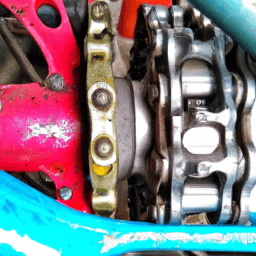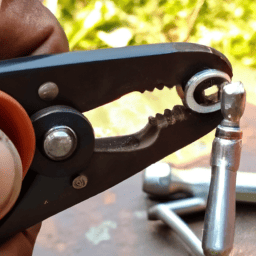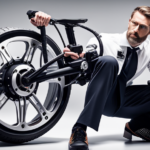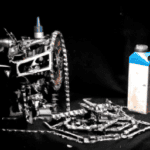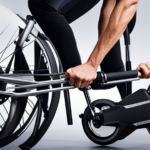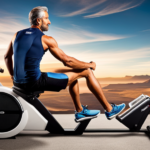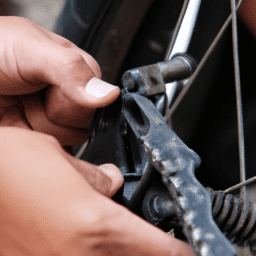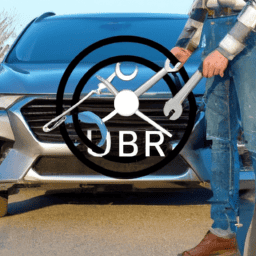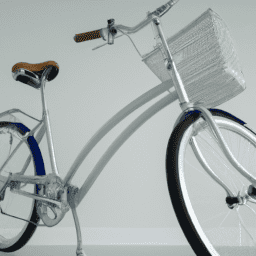Looking down the seemingly unending road in front of you, your legs threaten to collapse beneath you. After cycling for several hours, your destination remains frustratingly distant. Imagine if you could infuse your ride with an added boost of energy. Fitting your bike with a motor could potentially be the answer to your needs.
In this guide, we’ll walk you through the process of installing a motor on your bicycle. From choosing the right motor system to testing and adjusting the motor, we’ll cover everything you need to know to turn your ordinary bike into an electric powerhouse.
So, strap on your helmet, grab your tools, and let’s get started.
Key Takeaways
- There are three main types of motor systems: hub, mid-drive, and friction drive, with varying power, speed, and size.
- Proper preparation is key to a safe and functional end result, including checking compatibility with the bike type and securely installing the motor system.
- Regular maintenance is important to ensure safe operation and includes checking oil level, inspecting for wear and tear, cleaning the motor, and testing the throttle at different speeds.
- Safety precautions should be taken during installation and tool maintenance is crucial for success. Cost should also be considered when choosing a motor system, and professional consultation may be necessary for electrical connections.
Choose the Right Motor System
Don’t settle for a mediocre motor system when you could have the perfect one to transform your bike into a powerful machine. Before installing a motor, you need to choose the right system that meets your needs.
Motor system types vary in terms of power, speed, and size. There are three main types of motor systems: hub, mid-drive, and friction drive.
Hub motors are the simplest and most affordable type of motor system. They’re installed in the wheel hub and provide power to the wheel.
Mid-drive motors are more powerful and efficient than hub motors, but they’re also more expensive. They’re installed in the bike frame and provide power to the chain.
Friction drive motors are the least common type of motor system. They’re installed on the rear wheel and use friction to provide power.
When choosing a motor system, consider the cost comparison between the different types and choose the one that meets your needs and budget. Once you’ve chosen the right motor system, it’s time to gather the necessary tools to install it on your bike.
Gather the Necessary Tools
Before you get started, you’ll need to gather some tools that will make the process much easier. Apart from the motor system itself, you’ll need a few other items to complete the installation. These include a set of Allen keys, a wrench, a pair of pliers, a screwdriver, and a torque wrench.
It’s important to note that tool maintenance is key to ensuring the success of your installation. Before beginning, make sure that all your tools are in good condition and that they’re clean and dry. Additionally, you should take safety precautions such as wearing gloves and eye protection to avoid any accidents. Once you have all the necessary tools and have taken the necessary safety precautions, you can proceed to prepare your bike for installation.
Prepare Your Bike for Installation
Before installing a motor on your bicycle, you’ll need to prepare your bike. This involves removing any necessary parts such as the pedals, chain, and derailleur to make room for the motor.
You should also ensure that your bike is compatible with the motor system you’ve chosen to use. Check factors like frame size and wheel diameter.
Remember, it’s important to take the time to properly prepare your bike before installing a motor. This will ensure a smooth installation process and a safe, functional end result.
Remove Necessary Parts
First, you’ll need to take off the pedals and chain from your bike to continue with the installation of the motor. This will require a pedal wrench and a chain tool. Start by removing the pedals with the wrench, turning them counterclockwise. Once the pedals are off, use the chain tool to break the chain and remove it from the bike. Set aside both the pedals and chain for recycling. Not only is recycling important for the environment, but cycling itself is a great way to reduce your carbon footprint and improve your physical health.
Next, you’ll need to remove the rear wheel from your bike. This will allow you to access the frame more easily and make the installation process smoother. Refer to the table below for a step-by-step guide on how to remove the rear wheel:
| Step | Action |
|---|---|
| 1 | Shift the chain onto the smallest rear sprocket. |
| 2 | Loosen the quick release lever or bolts holding the wheel in place. |
| 3 | Lift the rear wheel out of the frame. |
With these parts removed, you can move on to the next step and check the compatibility of your bike with the motor system you have chosen.
Check Compatibility with Motor System
To ensure that your bike can accommodate the motor system you’ve chosen, you’ll want to check the compatibility by following these steps:
First, check the motor system’s specifications and compare them with your bike’s specifications. Look at the motor’s wattage, voltage, and amperage requirements. Make sure your bike’s frame can handle the added weight of the motor system and that the motor’s dimensions will fit the bike’s frame. You should also check if the motor system is compatible with the type of bike you have, such as a road bike, mountain bike, or beach cruiser.
Next, check the electrical connections of the motor system. Make sure that the motor system’s wires and connectors will fit your bike’s battery and controller. Check if the motor system comes with the necessary connectors and wiring, or if you need to purchase them separately. If you’re not sure about the electrical connections, it’s best to consult a professional mechanic or electrician to avoid any potential safety hazards.
Once you’ve confirmed the compatibility and electrical connections of your motor system, you can move on to installing the motor system onto your bike.
Install the Motor System
Now it’s time to get the motor system up and running, so let’s dive in and make your bike a powerful machine! Before you begin, ensure that the motor system is compatible with your bike and that you have the necessary tools for the installation. Once you have confirmed this, you can begin the installation process. Here are some motor installation techniques to keep in mind:
| Technique | Description | Tools Required |
|---|---|---|
| Bracket installation | Attaching the motor to the bike frame using brackets | Wrench, screwdriver |
| Wheel installation | Replacing the rear wheel with a motorized wheel | Wrench, screwdriver |
| Bottom bracket installation | Replacing the bike’s bottom bracket with a motorized one | Wrench, screwdriver |
Choose the technique that best suits your bike and motor system. Follow the manufacturer’s instructions carefully, as each system may have unique installation requirements. Once the motor is securely installed, move on to the next step of testing and adjusting the motor.
As you have successfully installed the motor system, it is now time to test and adjust it.
Test and Adjust the Motor
You’re ready to take your newly motorized bike for a spin and fine-tune the motor’s performance to your liking. Before you set off, it’s important to test the motor and make any necessary adjustments. Here are a few tips to help you get started:
-
Check the connections: Make sure all of the electrical connections are secure and the wires are correctly connected. Loose connections can cause the motor to malfunction or not work altogether.
-
Test the throttle: Ensure the throttle is working properly by testing it at different speeds. If the throttle is unresponsive, there could be an issue with the wiring or the motor’s internal components.
-
Adjust the brakes: If your motor has a lot of power, it’s important to have effective brakes. Test the brakes and adjust them as necessary to ensure you can stop quickly and safely.
-
Perform routine maintenance: Regular maintenance is key to keeping your motor running smoothly. Check the oil level and change it as necessary, inspect the motor for any signs of wear and tear, and clean the motor regularly to prevent dirt and debris from causing damage.
By following these troubleshooting techniques and performing regular motor maintenance, you can ensure your motorized bike runs smoothly and safely for years to come.
Happy riding!
Frequently Asked Questions
What kind of maintenance will be required for the motor system?
To maintain motor system durability, regularly check and tighten all connections, clean and lubricate moving parts, and replace worn components promptly. Troubleshooting tips include checking the battery charge and inspecting for any loose wires or damaged components.
How much weight can the motor system handle?
You need to consider the motor power output and battery life expectancy when determining the weight limit of the motor system. Proper calculation and installation can ensure the system can handle the desired weight without compromising performance or safety.
Can the motor system be used in rainy or wet conditions?
To protect the motor system from wet conditions, waterproofing solutions like silicone sealant can be used. However, excessive exposure to water can shorten the lifespan of the motor. Regular maintenance can help prevent damage caused by moisture.
Is it legal to use a motor system on a bicycle in all areas?
Before installing a motor system on your bike, consider the legal restrictions and safety concerns in your area. Some locations require licenses or have speed limits, while others prohibit the use entirely. Ensure you adhere to regulations and ride safely.
Can the motor system be easily removed or transferred to another bike?
"You can easily remove or transfer the motor system to another bike, but compatibility issues may arise. Consider the cost comparison of buying a new system versus transferring, and consult a professional for installation assistance."
Conclusion
Congratulations, you’ve successfully installed a motor on your bicycle! By following the steps outlined in this guide, you’ve transformed your traditional bike into a high-performing machine that can take on any terrain with ease.
But don’t stop here. There are endless possibilities for customizing and upgrading your motor system. Consider adding a battery pack for longer rides or a throttle for even greater control. With the right tools and techniques, you can continue to improve and enhance your motorized bicycle.
As you ride your newly motorized bike, you may feel a sense of freedom and power that you never experienced before. You’re now part of a community of bike enthusiasts who’ve found a way to make their rides more efficient, more enjoyable, and more exciting.
So go forth and explore the world on your motorized bicycle – the possibilities are endless!
